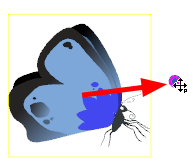Staging a Scene
Setting up your scene can be compared to building a set for a television show. This is the point when you position each scene element such as the camera frame, the background elements and the characters.
Adding a Camera
By default, a scene does not have a camera layer. In order to be able to tweak the scene's camera angle and position, you must add one to your scene. Although it is possible to have several cameras in the same scene, you can only view your scene using one camera at a time. This can be useful if you are still working on your scene composition and have different camera framing to try out.
- Do one of the following:
- In the Timeline view, click the Add Layer
button and select Camera.
- From the top menu, select Insert > Camera.
A new camera layer is added to the scene and appears in the Timeline view.

- From the top menu, select Scene > Camera.
- Among the listed cameras, select the one you want to work with.
Positioning the Camera
The scene action occurs inside the camera frame, so it’s really important to set it up correctly. You can adjust the camera resolution as well as other related parameters in the Scene Settings window, accessible from the Scene top menu.
Note that the Camera layer is static. If you need to animate it, you must put it under a peg, which you can animate—see Animating the Camera.
You can reposition your camera frame directly in the Camera view by using the Translate ![]() , Rotate
, Rotate ![]() and Scale
and Scale ![]() tools of the Advanced Animation toolbar. Alternatively, you can set up your camera by typing its coordinates directly in the camera's properties. This can be useful if you've done your scene planning on paper, as the coordinates match the ones on a traditional animation camera grid. Hence, using this approach allows you to position the camera exactly where you want it to be
tools of the Advanced Animation toolbar. Alternatively, you can set up your camera by typing its coordinates directly in the camera's properties. This can be useful if you've done your scene planning on paper, as the coordinates match the ones on a traditional animation camera grid. Hence, using this approach allows you to position the camera exactly where you want it to be
- In the Tools toolbar, disable the Animate
 mode.
mode.
- Do one of the following:
- From the top menu, select Animation > Tools > Translate.
- In the Advanced Animation toolbar, click the Translate
tool.
- Press Alt + 2.
- In the Camera view, click on the camera frame (thin rectangle) to select it. You can also select the camera layer from the Timeline view.
The selected camera frame is highlighted.
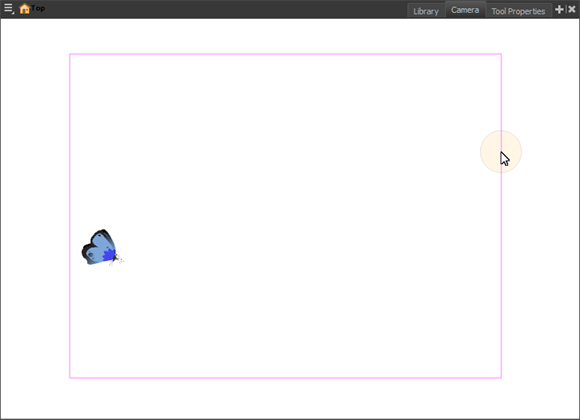
- Drag the camera frame to a new position.
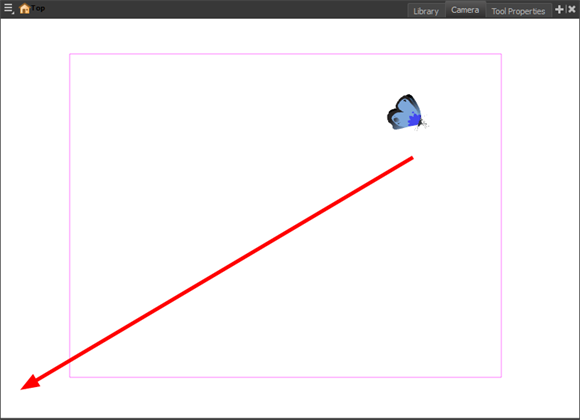
- To tilt the camera frame, do one of the following to select the Rotate tool:
- From the top menu, select Animation > Tools > Rotate.
- In the Advanced Animation toolbar, select the Rotate
tool.
- Press Alt + 3.
- In the Camera view, drag to rotate the camera frame until it reaches the desired rotation angle.
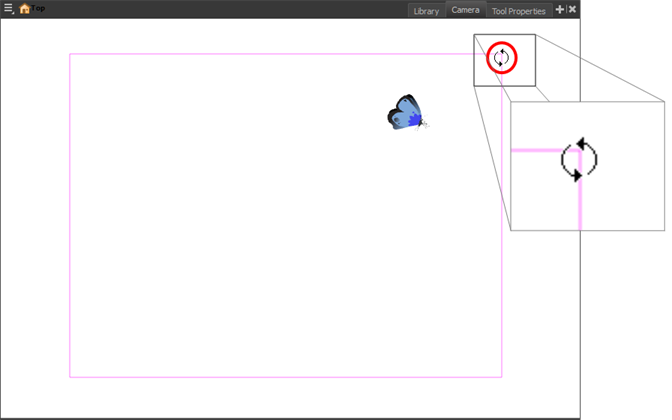
- To move camera frame closer to or further away from the scene, do one of the following to select the Scale tool:
- From the top menu, select Animation > Tools > Scale.
- In the Advanced Animation toolbar, select the Rotate
tool.
- Press Alt + 4.

- In the Tools toolbar, select the Transform
 tool or press Shift + T.
tool or press Shift + T.
- In the Timeline or Camera view, select the camera layer.
- From the top menu, select Animation > Reset or press Shift + R.
The camera automatically returns to its original position.
Positioning Objects
Setting up the scene also involves positioning the different scene elements within the camera frame.
- In the Tools toolbar, disable the Animate
 mode.
mode.
- In the Tools toolbar, select the Transform
 tool or press Shift + T.
tool or press Shift + T.
- In the Tool Properties view, make sure the Peg Selection Mode
 is deselected.
is deselected.
- In the Camera view, select a drawing layer and drag the selection to a new area. You can select multiple layers to reposition them at the same time. Hold down Shift and select the different layers.

- In the Tools toolbar, disable the Animate
 mode.
mode.
- In the Tools toolbar, select the Transform
 tool or press Shift + T.
tool or press Shift + T.
- In the Tool Properties view, make sure the Peg Selection Mode
 is deselected.
is deselected.
- In the Camera view, select a drawing layer.
- Place the pointer outside of a corner of the bounding box and drag to rotate.
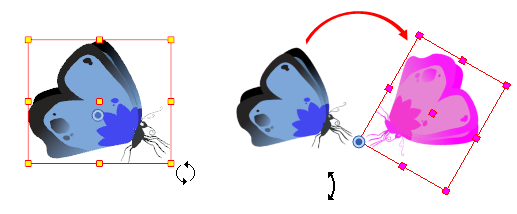
- In the Tools toolbar, enable or disable the Animate
 mode if you want to animate or not.
mode if you want to animate or not.
- In the Tools toolbar, select the Transform
 tool or press Shift + T.
tool or press Shift + T.
- In the Tool Properties view, make sure the Peg Selection Mode
 is deselected.
is deselected.
- In the Camera view, select a drawing layer and push or pull on the size, top, or corner control point. Hold down Shift to lock the selection's aspect ratio.
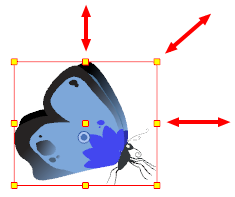
- In the Tools toolbar, disable the Animate
 mode.
mode.
- In the Tools toolbar, select the Transform
 tool or press Shift + T.
tool or press Shift + T.
- In the Tool Properties view, make sure the Peg Selection Mode
 is deselected.
is deselected.
- In the Camera view, select a drawing layer.
- Place the pointer between two controls points and drag sideways or up and down.
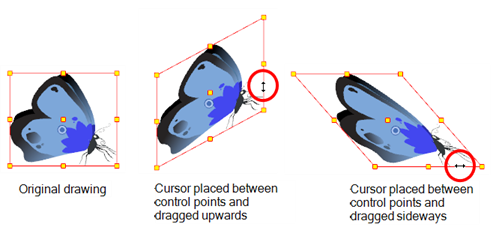
Repositioning the Pivot
Transformations made on a drawing layer, such as rotation, scale, skew and flip, are made relative to the position of the drawing's pivot point. While making transformations using the Transform tool, you can drag and drop your selection's pivot. However, this has no permanent effect. It will only temporarily change the pivot's position to help you make transformations at the selected frame, but the actual pivot point of your drawing layer will remain the same. You can reposition a layer's pivot point permanently using the advanced animation tools.
- In the Advanced Animation toolbar, select the Translate
 , Rotate
, Rotate  , Scale
, Scale  , or Skew
, or Skew  tool.
tool.
- In the Camera view, Ctrl + click (Windows/Linux) or ⌘ + click (Mac OS X) to select your element.
The pivot point appears in the Camera view.
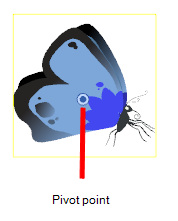
- Drag the pivot point to a new position.
